
Bycatch, in the fishing industry, is a fish or other marine species that is caught unintentionally while fishing for specific species or sizes of wildlife. Bycatch is either the wrong species, the wrong sex, or is undersized or juveniles of the target species. The term "bycatch" is also sometimes used for untargeted catch in other forms of animal harvesting or collecting. Non-marine species that are caught but regarded as generally "undesirable" are referred to as rough fish or coarse fish.
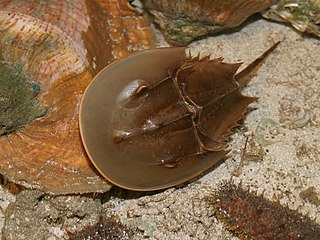
The Atlantic horseshoe crab, also known as the American horseshoe crab, is a species of horseshoe crab, a kind of marine and brackish chelicerate arthropod. It is found in the Gulf of Mexico and along the Atlantic coast of North America. The main area of annual migration is Delaware Bay along the South Jersey Delaware Bayshore.
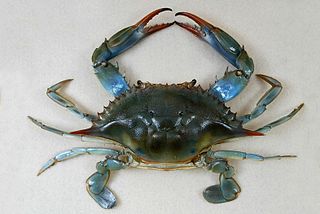
Callinectes sapidus, the blue crab, Atlantic blue crab, or, regionally, the Maryland blue crab, is a species of crab native to the waters of the western Atlantic Ocean and the Gulf of Mexico, and introduced internationally.

Litopenaeus setiferus is a species of prawn found along the Atlantic coast of North America and in the Gulf of Mexico. It was the subject of the earliest shrimp fishery in the United States.

The Japanese spider crab is a species of marine crab and is the biggest one that lives in the waters around Japan. At around 3.7 meters, it has the largest leg-span of any arthropod. The Japanese name for this species is taka-ashi-gani,, literally translating to "tall legs crab". It goes through three main larval stages along with a prezoeal stage to grow to its great size.

The Dungeness crab makes up one of the most important seafood industries along the west coast of North America. Its typical range extends from Alaska's Aleutian Islands to Point Conception, near Santa Barbara, California. Dungeness typically grow 6–7 in (150–180 mm) at their widest point and inhabit eelgrass beds and sandy bottoms. Its common name comes from the Dungeness Spit in the Strait of Juan de Fuca, Washington state, United States, which shelters a shallow bay inhabited by the crabs.
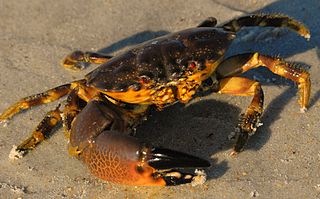
The Florida stone crab is a crab found in the western North Atlantic, from Connecticut to Colombia, including Texas, the Gulf of Mexico, Belize, Mexico, Jamaica, Cuba, The Bahamas, and the East Coast of the United States. The crab can also be found in and around the salt marshes of South Carolina and Georgia. It is widely caught for food. The closely related species Menippe adina is sometimes considered a subspecies – they can interbreed, forming hybrids – and they are treated as one species for commercial fishing, with their ranges partly overlapping. The two species are believed to have diverged approximately 3 million years ago.

The loggerhead sea turtle is a species of oceanic turtle distributed throughout the world. It is a marine reptile, belonging to the family Cheloniidae. The average loggerhead measures around 90 cm (35 in) in carapace length when fully grown. The adult loggerhead sea turtle weighs approximately 135 kg (298 lb), with the largest specimens weighing in at more than 450 kg (1,000 lb). The skin ranges from yellow to brown in color, and the shell is typically reddish brown. No external differences in sex are seen until the turtle becomes an adult, the most obvious difference being the adult males have thicker tails and shorter plastrons than the females.
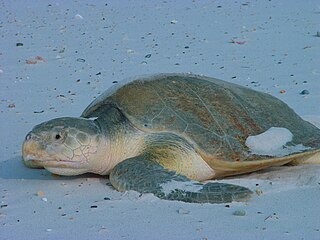
Kemp's ridley sea turtle, also called commonly the Atlantic ridley sea turtle, Kemp's ridley turtle, and Kemp's ridley, is a species of turtle in the family Cheloniidae. L. kempii is the rarest species of sea turtle and is the world's most endangered species of sea turtle. It is one of two living species in the genus Lepidochelys. The species L. kempii primarily occupies habitat around the Gulf of Mexico, though its migrations into the Atlantic Ocean are being affected by rising temperatures. Kemp's ridley sea turtle is listed as endangered under the Endangered Species Act (ESA), and conservation efforts are attempting to rebuild population numbers. Human activity, including but not limited to habitat destruction, climate change, and oil spills, threaten populations.

The Jonah crab is a marine brachyuran crab that inhabits waters along the east coast of North America from Newfoundland to Florida. Jonah crabs possess a rounded, rough-edged carapace with small light spots, and robust claws with dark brown-black tips. The maximum reported carapace width for males is 8.7 in (222 mm), while females rarely exceed 5.9 in (150 mm). It is the closest relative to the European brown crab in the Western Atlantic.
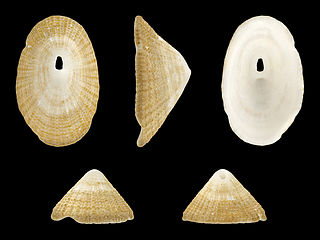
Diodora cayenensis, the Cayenne keyhole limpet, is a species of small to medium-sized sea snail or limpet, a western Atlantic marine prosobranch gastropod mollusk in the family Fissurellidae, the keyhole limpets.

Crab meat or crab marrow is the meat found within a crab, or more specifically in the leg of a crab. It is used in many cuisines around the world for its soft, delicate and sweet flavor. Crab meat is low in fat and provides approximately 340 kilojoules (82 kcal) of food energy per 85-gram (3 oz) serving. Brown crab, blue crabs, blue swimming crabs, and red swimming crabs are among the most commercially available species of crabmeat globally.

Menippe is a genus of true crabs. One of the best known species is the Florida stone crab. Most of the species of this genus are found in the Atlantic Ocean.

Mithraculus sculptus, the green clinging crab or emerald crab, is a species of crab in the family Majidae. It is a dark green colour and is found in tropical waters in the Caribbean Sea. It is sometimes kept in reef aquaria.

The hawksbill sea turtle is a critically endangered sea turtle belonging to the family Cheloniidae. It is the only extant species in the genus Eretmochelys. The species has a global distribution that is largely limited to tropical and subtropical marine and estuary ecosystems.
M. mercenaria may refer to:

Dyspanopeus sayi is a species of mud crab that is native to the Atlantic coast of North America. It has also become established outside its native range, living in Swansea Docks since 1960, the Mediterranean Sea since the 1970s, the North Sea since 2007 and the Black Sea since 2010. It can reach a carapace width of 20 mm (0.8 in), and has black tips to its unequal claws. It feeds on bivalves and barnacles, and is in turn eaten by predators including the Atlantic blue crab, Callinectes sapidus. Eggs are produced from spring to autumn, the offspring reach sexual maturity the following summer, and individuals can live for up to two years. The closest relative of D. sayi is D. texanus, which lives in the Gulf of Mexico; the two species differ in subtle features of the genitalia and the last pair of walking legs.
Declawing of crabs is the process whereby one or both claws of a crab are manually detached before the return of the live crab to the water, as practiced in the fishing industry worldwide. Crabs commonly have the ability to regenerate lost limbs after a period of time, and thus declawing is viewed as a potentially more sustainable method of fishing. Due to the time it takes for a crab to regrow lost limbs, however, whether or not the practice represents truly sustainable fishing is still a point of scientific inquiry, and the ethics of declawing are also subject to debates over pain in crustaceans.
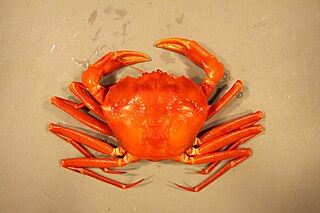
Chaceon quinquedens, commonly known as the red deep-sea crab, but sold as Atlantic deep sea red crab, or simply Atlantic red crab or red crab, is a crab that lives in the Atlantic Ocean off the East Coast of the United States and Canada, from North Carolina to Nova Scotia, and in the Gulf of Mexico.

Hapalogaster dentata, also called the stone crab or the spiny stone crab, is a species of king crab. It is found in shallow waters in the Yellow Sea on the western Korean Peninsula, the Sea of Japan near Peter the Great Gulf, and along the coast of Japan as far north as Hokkaido and as far south as Kyushu.

















